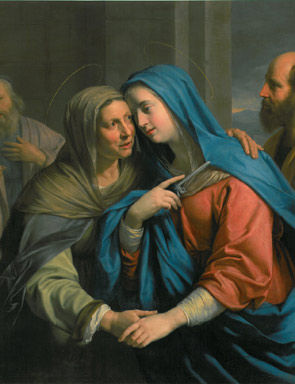Seattle Art Museum announces two new 17th-Century European acquisitions
Francisco de Zurbarán, (Spanish, 1598 - 1664), The Flight into Egypt, late 1630s. Oil on canvas, 59 1/16 x 62 5/8in. (150 x 159cm). Seattle Art Museum, Partial and promised gift of Barney A. Ebsworth Collection
SEATTLE, WA.- The Seattle Art Museum announced today that it has acquired two new important paintings for the European collection. Both of these works of art are fractional gifts to the museum from local collector and SAM Trustee Barney A. Ebsworth. Francisco Zurbarán’s (Spanish, 1598-1664) The Flight into Egypt (late 1630’s) addresses events following the birth of Jesus. Philippe de Champaigne’s (French, 1602-74) The Visitation (1643) is one of four paintings devoted to the Virgin Mary that were created for the family chapel of an official in the French royal court at the Church of the Oratory of Jesus in Paris. Both paintings will be displayed for the first time at the Seattle Art Museum starting Wednesday, December 21, 2011 in the European baroque galleries.
The Flight into Egypt, late 1630s
Seventeenth-century religious painters strove to make stories from the Bible real and urgent for their contemporary audiences. Francisco de Zurbarán, noted painter of Spain’s Golden Age, portrays Joseph and Mary fleeing to Egypt after Joseph had a prophetic dream that the jealous King Herod would threaten his infant son’s life. The Virgin and Child are portrayed as ordinary citizens, yet their frontal orientation invites devout veneration. Joseph, walking next to the donkey and attending to his wife and son, wears the broad hat, cloak and staff typical of a religious pilgrimage.
Francisco de Zurbarán, born 1598 in Extremadura, was a Spanish painter known for his crisp painting style and unusual color sense, which he employed both in deeply moving religious works as well as still lifes.
Philippe de Champaigne, The Visitation, ca. 1643. Oil on canvas, 44 1/4 x 38 1/2in. Seattle Art Museum, Partial and promised gift of the Barney A. Ebsworth Collection
The Visitation, ca. 1643
One of Europe’s most penetrating portraitists of the seventeenth century, Philippe de Champaigne brought his observations of real people into religious paintings, giving them a genuine and natural quality. In The Visitation, the central focus is the aged face of Elizabeth as she affectionately greets her younger cousin, the Virgin Mary. Only the haloes suggest the divine identities of the two pregnant women, Elizabeth with John the Baptist and Mary with Jesus. According to the Gospel of Luke “when Elizabeth heard the salutation of Mary, the infant leaped in her womb.” For Christians, this joyous response by John, the last prophet of the Old Testament, symbolized the transition from the Old Law to the New Dispensation of Christianity.
Born in Brussels in 1602, Champaigne was a key artist working in 17th-century France. His work established a style based on rationalism and directness, qualities which also mark his celebrated portraiture. His mature paintings display an understated, cool clarity characteristic of the French baroque.

/https%3A%2F%2Fprofilepics.canalblog.com%2Fprofilepics%2F1%2F0%2F100183.jpg)
/https%3A%2F%2Fstorage.canalblog.com%2F03%2F02%2F119589%2F96711876_o.jpg)
/https%3A%2F%2Fstorage.canalblog.com%2F11%2F31%2F119589%2F94773502_o.jpg)
/https%3A%2F%2Fstorage.canalblog.com%2F20%2F83%2F119589%2F94772815_o.jpg)
/https%3A%2F%2Fstorage.canalblog.com%2F26%2F72%2F119589%2F75604929_o.jpg)
/https%3A%2F%2Fstorage.canalblog.com%2F59%2F60%2F119589%2F26458628_o.jpg)




/http%3A%2F%2Fstorage.canalblog.com%2F18%2F20%2F119589%2F121102965_o.jpg)
/http%3A%2F%2Fstorage.canalblog.com%2F33%2F97%2F577050%2F39651117_p.jpg)
/http%3A%2F%2Fstorage.canalblog.com%2F39%2F52%2F119589%2F30807657_o.jpg)
/http%3A%2F%2Fstorage.canalblog.com%2F15%2F78%2F119589%2F127923120_o.jpg)